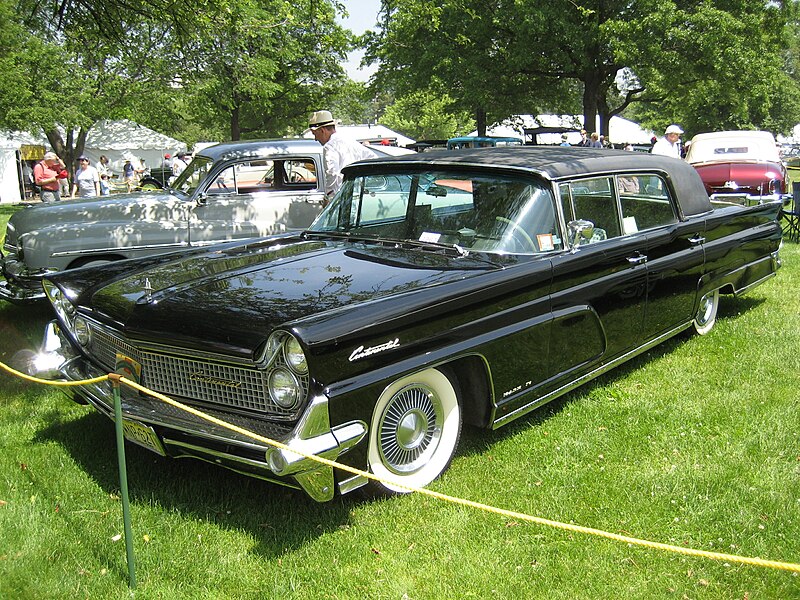To build a better business case for its flagship and the division that marketed the vehicle, for 1958, Ford Motor Company made extensive changes to its Continental Division. To widen its sales potential, Ford required Continental to reach a $6000 price (a 40% reduction from the Mark II), allowing the division to better compete against Cadillac Eldorado and Imperial LeBaron. To allow for production at a larger scale, the Continental model line was more closely integrated with Lincoln, differing primarily in roofline, trim, and grille.
In 1959, Ford ended the Continental Division; its model line lived through 1960 alongside Lincoln.
To facilitate continuation of the Continental model line, the division was forced to abandon hand-built construction. Sharing a common chassis and much of the exterior of the Lincoln Premiere, Continental production shifted to the then-new Wixom Assembly plant.
To set itself apart from a Lincoln, along with a division-specific grille, all versions of the Continental (including convertibles) were styled with a reverse-slant roofline, fitted with a retractable "breezeway" rear window. First introduced on the 1957 Mercury Turnpike Cruiser, the feature allowed for augmented interior ventilation (along with air conditioning). The Continental Mark III was designed by John Najjar, Chief Stylist of Lincoln, assisted by Elwood Engel. Engel would style the 1959 Mark IV, with Don Delarossa (who replaced Najjar as Lincoln Chief Stylist in 1957) developing the 1960 Mark V. Nicknamed the "slant-eyed monster" in the Ford design studio, the 1958-1960 Continentals and Lincolns would become one of the largest vehicles ever built by Ford Motor Company
The 1958-1960 Continental Mark III-V are built upon the same chassis utilized by the Lincoln Capri and Lincoln Premiere. For 1958, Lincoln split from Mercury in body design, with Lincoln adopting unibody construction for the first time; the Continental shares a common body with the Premiere, with the exception of the reverse-slant roofline.
Shared with Lincoln, Mercury, and the Ford Thunderbird, the Continental Mark III-Mark V were fitted with a 430 cubic-inch MEL V8 engine; a 3-speed Turbo-Drive automatic was the sole transmission. In 1958, the engine produced 375 hp, and was retuned to 350hp in 1959, making 315 hp in 1960.
Using a 131-inch wheelbase, the 1958 Continentals are the longest-wheelbase sedans ever built by Ford Motor Company. Longer than a Ford Excursion, the 1958-1960 Continentals are the longest sedans ever produced by Ford without 5mph bumpers. The 1958 Continental Mark III convertible is the longest convertible ever mass-produced in the United States, with the sole exception of the (extremely rare) 1934-1937 Cadillac V16 convertibles.
Models
In line with the previous Continental naming tradition, Continental introduced its 1958 model line as the Mark III. In a break from previous generations, each model year is assigned a separate name.
Mark III (1958)
For 1958, Continental released the Mark III in four bodystyles, including a 2-door hardtop and convertible, a 4-door pillared sedan, and a four-door hardtop sedan (called Landau). Although far less expensive than the Mark II, the Mark III remained well-equipped, retaining air conditioning as an option (relocated from the ceiling to the dashboard). The Mark III became the first Ford Motor Company vehicle to offer an FM radio tuner (as a rarely ordered option). A unique option was "Auto Lube", allowing for the car to lubricate itself (as long as an oil reservoir was kept full).
Mark IV (1959)
For 1959, the Continental Mark IV saw a minor restyling, with the elimination of Dagmars from the front bumpers. Coinciding with the end of the Continental Division, "Continental III" fender badging is replaced by separate "Continental" and "Mark IV" badging. The grille is restyled slightly, with the headlight clusters integrated into the egg-crate grille.
Mark V (1960)
For 1960, the Continental Mark V saw another styling update, with flatter front bumpers (with Dagmars). The Continental badging was restyled, with "Mark V" badging moved to the rear fenders. On the front fenders, several horizontal chrome strakes were added. Using a similar layout as the Mark IV, the Mark V was given a restyled gril



.jpg/1280px-Continental_Mk._III_1958_(4).jpg)
.jpg/1920px-Continental_Mk._III_1958_(2).jpg)
.jpg/1024px-Continental_Mk._III_1958_(1).jpg)
.jpg/800px-1958_Lincoln_Continental_Mark_III_(6235965883).jpg)

.jpg/1024px-Sunburg_Trolls_1959_Lincoln_Continental_Mark_IV_Convertible_(36933578711).jpg)
.jpg/1024px-Sunburg_Trolls_1959_Lincoln_Continental_Mark_IV_Convertible_(36261380233).jpg)









.jfif)

No comments:
Post a Comment